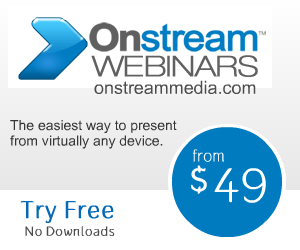Given the rapid way online technology changes, there is no longer any doubt that using video in business for the promotion of your brand, service, organization or message is a tremendously valuable means of advertisement.
One of the best ways to reach a lot of people, potentially drawing in new clients or customers, is through a webcast. A webcast is a video production that can be streamed or archived on the world wide web. It may be prerecorded or streamed to viewers on a global scale. Unlike a webinar, a webcast is a one-way means of communication, and therefore is often less targeted to specific users, but meant for a wide range of potential viewers.
Setting up a webcast doesn't have to hurt. There are several steps you can take in order to make it a painless process. Most people have fast internet connections, so this usually should not be a problem. But if you are hosting a live streaming event, you want to make sure your connection has the capacity to handle it, as well as enough bandwidth to deliver your content live to numerous viewers around the world. Any deficiency in this area could reflect poorly on your brand, generate mistrust, and tarnish your message.
For this reason, your production values need to be of the highest quality. A video camera that records in HD (high definition) is preferable, if possible, and you may want more than one cameraman in order to capture large, live events. The idea behind a webcast is that you are enabling distant viewers who cannot otherwise attend to feel like they are actually present. Planning for your webcast should include lots of preparation in order to achieve the illusion of presence through video, including superior script writing, seamless direction and flow, non-intrusive editing (for prerecorded events), and an emphasis on message that is direct and to the point. People watching webcasts online are not likely to continue watching poor quality productions; they are just a click away from tuning in on something else. So it is important to keep them entertained with enough variety and superior content if you want to deliver your message effectively and without distractions.
Of course, if your webcast is much narrower in purpose, such as a mere communique to followers or subscribers, you may be able to record it at home with a high quality webcam. You will still want to pay attention to production values, be succinct, practice and follow a basic, scripted outline, and deliver a polished presentation. Make sure your speakers are on message, know their material, and can concisely and energetically convey it. People will likely not listen to someone who rambles and repeats himself endlessly, nor someone who speaks in a monotone or is reading to the virtual audience. Part of planning is putting together effective, powerful content. People are drawn in to stories, so using narrative, if possible, as you deliver your message is one of the best ways to keep interest while simultaneously promoting your organization, company, brand, service or message.
Advertising your event may or may not suit your purposes. If you plan to stream live, you may want to register users ahead of time and remind them via email as the event approaches. Using social media can also significantly promote your event through word-of-mouth. For live events, specifying a date and time is important, as is sticking with it. You may also want to edit and archive a live streaming event so that people can download it and watch at their own leisure. Prerecorded events can still have a launch date, and once you have it available to watch, either embedded in your website or to be downloaded, you may want to make an announcement to subscribers, or on your website, and again, through the powerful potential of word of mouth that is available via social networking sites. If it suits your purposes and you are trying to reach as many people as possible, you might also consider posting your completed webcast on a video site such as YouTube (or similar sites)in order to gain more exposure.
Most of the work is in the preparation. If you are doing a prerecorded webcast, don't rely on editing. Try to make it work as though you will not need to edit. Badly edited webcasts can not only distract viewers from the message of the video, but also reflect poorly on your affiliations. Ninety percent of the work invested in a live webcast should be in the planning stage, bearing down on details for direction and delivery, and doing test runs before the actual event occurs.




